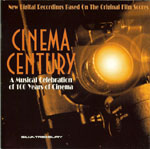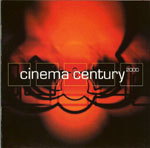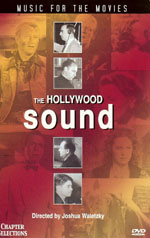 Screening Music:
Screening Music:
On the art and history of music composed for film
By Steve Vertlieb
Motion pictures are, themselves, some one hundred and nine years old. Even before the advent of sound in 1926 with the John Barrymore production of DON JUAN, music had become an integral part of the motion picture experience. Organs and their accompanists usually played either dramatic or comedic counterpart to the imagery unfolding on the theatre screen while, in some of the larger film palaces scattered across the country, a live orchestra might perform exciting background accompaniment for some of the nation’s more prestigious films and audiences.
.jpg) When Al Jolson filmed the premiere of the “ talking picture ” for release in 1927, appetite for sound and music mushroomed virtually overnight. THE JAZZ SINGER revolutionized the fledgling film industry, relegating the once popular silent film to commercial oblivion. The studios couldn’t crank out films with some degree of sound quickly enough, and those who decided to drag their feet saw their artistic legs crushed beneath the weight of exhibitors chariots. The silence was gone forever and, with it, a bit of the charm and magic that had made the film experience so enchanting to begin with.
When Al Jolson filmed the premiere of the “ talking picture ” for release in 1927, appetite for sound and music mushroomed virtually overnight. THE JAZZ SINGER revolutionized the fledgling film industry, relegating the once popular silent film to commercial oblivion. The studios couldn’t crank out films with some degree of sound quickly enough, and those who decided to drag their feet saw their artistic legs crushed beneath the weight of exhibitors chariots. The silence was gone forever and, with it, a bit of the charm and magic that had made the film experience so enchanting to begin with.
Scripts were unimportant as the tide rose to drown the silence. An art form that had risen to the very peak of sensual beauty and impeccable design had to fall back behind the trenches and learn its craft all over again. It was a brave new world in which careers and fortunes would either burgeon or crumble into irretrievable ruin. In those early tumultuous days, little mattered beyond extricating the crudity of sound from the flickering image on the screen. Audiences eager to hear, as well as see, the performers they’d grown to love were often disappointed by the screeching babble emanating from the vocal chords of the beautiful figures painted onto the screen. Careers were ruined. Careers were born. Hollywood campaigned vigorously to enlist the participation of New York and the hallowed stages of the Broadway theatre where vocal intonation and perfection were demanded by more sophisticated audiences.
However, the most important element desired both by studios and audiences alike was the proliferation of music. Broadway composers and orchestrators flocked to Hollywood, as well, to take permanent root beneath the palm trees adorning sunset boulevards of broken dreams, and music rose through the celluloid rafters of every soundstage in Tinseltown. Performers were placed into every conceivable circumstance from which might derive an excuse to break out into song. They were singin’ in the rain, and the sun, on the ceiling and the floor. The most popular song writers from Tin Pan Alley abandoned the Great White Way, and flourished in Hollywood. Irving Berlin, George and Ira Gershwin, and Cole Porter were counted among the many musical stalwarts setting up shop amidst sound and fury.
Musicals, however, were not alone in their insistence on re-inventing the wheel. Dramatic films were equally demanding in their search for fresh musical talent. Background music leapt to the foreground, soon becoming a dominant force in American cinema, as classical European influences proliferated the scoring stages of the major studios. New and exciting composers were finding a lasting voice on the motion picture screen, creating a wealth of rich symphonic heritage that came to be known as “The Hollywood Sound.” This was to be the beginning of a golden era of musical artistry in which many of the most important composers of the period would flourish and mature within the nurturing sanctuary of the studio system. Each of the major studios created its own singular music department, complete with scoring stages, studio contract musicians and resident department heads.
I t wasn’t long before each of the studios had developed and perfected its own individual sound. Much of the most beautiful symphonic music of the twentieth century can be directly attributed to Hollywood during the nineteen thirties, forties and fifties. Where films needed emotional punch or dramatic escalation, perhaps lacking in either direction or performance, the composer was brought in to deliver unspoken suspense or a passionate exclamation point. It was rightly stated that more bad films were saved by good music that can ever be accurately calculated.
t wasn’t long before each of the studios had developed and perfected its own individual sound. Much of the most beautiful symphonic music of the twentieth century can be directly attributed to Hollywood during the nineteen thirties, forties and fifties. Where films needed emotional punch or dramatic escalation, perhaps lacking in either direction or performance, the composer was brought in to deliver unspoken suspense or a passionate exclamation point. It was rightly stated that more bad films were saved by good music that can ever be accurately calculated.
Not everyone was persuaded by the legitimacy of the so called “Hollywood Sound,” however. Critics were especially hard on the new art form, condemning what they considered saccharine and trite. Film composers became the bastard step children of “serious” musicians. Indeed, the very term “film composer” soon became the worst and most condescending pejorative in the industry. That many of the most gifted film composers also had substantial concert hall careers, writing operas and symphonies, seemed to matter little to closed minded, dictatorial and snobbish music critics on the most culturally prestigious newspapers and magazines in the country. A classic story persists to this day about a popular radio program on which some of the country’s most distinguished critics were challenged weekly to “name that tune.” An isolated music track would be played for the esteemed musicologists who would attempt to guess its derivation and composer. One such extract was played for the gentlemen of the press, all of whom managed to exchange high praise for the work, citing its many classical influences and rich cultural style and influence. All expressed unbridled admiration for the piece, while unable to identify either its name or composer. When the identity of the composer was revealed at last as Miklos Rozsa, the sneering panelists recanted their earlier enthusiasm and praise, reducing the status of the composer and referring to him, snidely, as “Oh, the film guy.”

Despite this insufferable snobbery, few would deny the nearly legendary status of such golden age film composers as Miklos Rozsa, Bernard Herrmann, Erich Wolfgang Korngold, Alfred Newman, Franz Waxman, Dimitri Tiomkin, Max Steiner, Victor Young, David Raksin, Bronislau Kaper, William Alwyn, John Green and Hugo Friedhofer…or their silver age cultural descendants such as Elmer Bernstein, Alex North, Andre Previn, Jerome Moross, Jerry Goldsmith and John Williams. Ralph Vaughan Williams, Phillip Sainton and Leonard Bernstein all composed for motion pictures, while Richard Rodgers contributed several scores for television.
Obviously, those who scorn the music of the movies are more invested in their own stodgy reputations and miniscule parameters than in a genuine love of musical expression, for few avenues of creative endeavor have given as much freedom and creative permission to its artists as has the motion picture industry.
The greatest composers have allowed their imaginations and talent to soar with eagles, finding limitless creativity and challenge in the flickering light of the celluloid image.
Recommended DVD

If you enjoy music from older films, this DVD is highly recommended.
It is hosted with great candor by John Mauceri and includes music by Erich Wolfgang Korngold, Alfred Newman, David Raksin, Max Steiner, Dimitri Tiomkin, and Franz Waxman, and all the film scores mentioned are on the 100 Essential Film Scores list [see below].
This DVD is well worth adding to your collection:
Music for the Movies: The Hollywood Sound
Now Available!
.jpg)
The new updated 3rd edition of A Guide to Film Music -- Songs and Scores is now available from PineTree Press.
The book covers the years from 1926 to 2006.
To read about this film music guide, go to
Film Composers and Soundtracks
 100 Essential Film Scores
100 Essential Film Scores 
What are the 100 essential film scores of the 20th century?
To see the list, go here.
